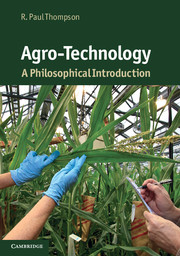Book contents
- Frontmatter
- Contents
- List of figures
- List of tables
- Preface
- Introduction
- 1 Scientific background
- 2 Application of genetics to agriculture
- 3 Philosophical and conceptual background
- 4 The controversy
- 5 The controversy
- 6 The controversy
- 7 The organic alternative
- 8 Impacts on low- and middle-income countries
- Concluding remarks
- Bibliography
- Index
Concluding remarks
Published online by Cambridge University Press: 05 June 2012
- Frontmatter
- Contents
- List of figures
- List of tables
- Preface
- Introduction
- 1 Scientific background
- 2 Application of genetics to agriculture
- 3 Philosophical and conceptual background
- 4 The controversy
- 5 The controversy
- 6 The controversy
- 7 The organic alternative
- 8 Impacts on low- and middle-income countries
- Concluding remarks
- Bibliography
- Index
Summary
In the years ahead, we, and the generations that follow us, will face known and currently unknown challenges. Science and technology will always be a part of the solution for most of them. Hence, opposition to science and technology is almost always imprudent. Equally imprudent is an unquestioning embrace of everything flowing from science and technology. In this spirit, this book has emphasised two main themes. First, important, critical issues are always complex and navigating a course to a resolution requires avoiding extremes and avoiding simple ‘this way or the wrong way’ dichotomies. That, in part, is why opposition to science and technology (one extreme pole) and unquestioning embrace of science and technology (the other extreme pole) are to be avoided. Second, no activity is without risk of harm – even lying in bed. Activities bring benefits and harms or risks of harms; to pretend otherwise is irrational and imprudent. The rational approach to decision-making involves an examination of benefits and harms (both inextricably value-laden) and balancing them through analysis; if engaging in the activity is the resulting choice, mitigation and management of harms to the maximum extent possible is the rational course. This is the rational and prudent approach for individuals and for societies.
Much of the GM agriculture debate has been dominated by portrayals of the harms – some real, many fabricated. When the harms, for which evidence can be adduced, are balanced with the benefits, for which evidence can be adduced, a more accurate determination of rationally defensible courses of action can be made. When GM crops and the foods derived from them are assessed in this way, the benefits, I contend, outweigh the harms. That has been a central message of the book, a message around which much of the argumentation has revolved. More importantly, though, success, for me, will not be measured in terms of the number of people who come to agree with its message but rather in terms of the number of people whose analytical skills have been enhanced. Hence, someone who rejects the central message but does so by using evidence and analytical tools is an instance of success. In the end, dialogue and debate is not about winning but about grappling rationally with complex matters and developing tentative positions, positions that can, and almost certainly will, be refined and transformed over time. That is the intellectually honest and most beneficial (individually and socially) approach to forming positions and making decisions.
- Type
- Chapter
- Information
- Agro-TechnologyA Philosophical Introduction, pp. 214 - 215Publisher: Cambridge University PressPrint publication year: 2011

